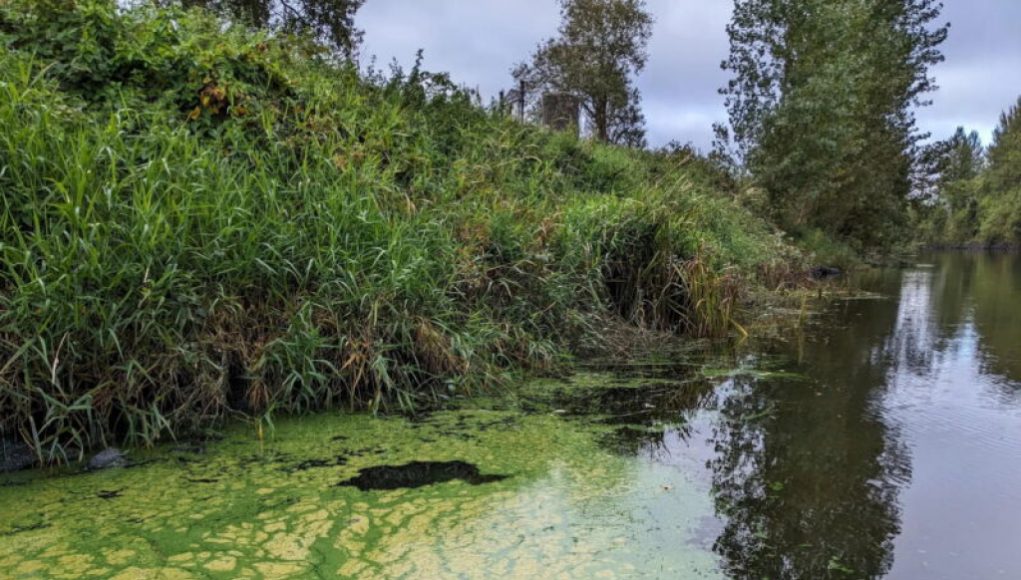Standing on the marina, Rob Skelly gazes into the dark river, watching as bright specks of algae float by. A neon green invader. “It’s starting to grow,” he says. “Tomorrow, you’ll see clumps like that all over the river—and the day after, even more.”
Until this summer, Skelly had never witnessed algae wax and wane like this in the River Bann, a major waterway in Northern Ireland. He established his thriving water sports business, the Cranagh Activity Centre, 27 years ago, and it has been in this location since 2015. But the algae has destroyed it. After news reports of toxin-producing blue-green algae in lakes and rivers across Northern Ireland, people began canceling their bookings for water-skiing lessons and other activities in droves.
Skelly understands their concerns. “How can I put customers in that?” he asks, looking at the mottled water below. With the season ruined, Skelly has made the heartbreaking decision to permanently close his business.

Blue-green algae is becoming a common problem in rivers and lakes worldwide, largely due to the climate crisis. Despite their name, blue-green algae are not actually algae, but a group of photosynthesizing bacteria called cyanobacteria. Under the right conditions, they can rapidly multiply across large bodies of water, leaving grayish-blue marks at the edges. These blooms often come with a foul smell.
These bacteria can produce large amounts of toxins called cyanotoxins, which can cause various health issues in humans and animals. Outbreaks have even been linked to pet and livestock deaths. People living near lakes with regular cyanobacteria blooms have a higher risk of liver cancer, and there is some research suggesting a connection to motor neurone disease. Cyanotoxins can also be inhaled during recreational activities or fishing when water is disturbed.
Genetic analysis indicates that cyanobacteria have been around for about 3 billion years. While sewage dumping and nutrient runoff from farms have long contributed to their growth, cyanobacteria are now thriving due to rising global temperatures and CO2 levels.
Advertisement
“That, I think, is the really compelling evidence for the link to climate change—we’re seeing these increases in places where there hasn’t been a substantial increase in urbanization or fertilizer use,” says Hans Paerl from the University of North Carolina-Chapel Hill’s Institute of Marine Sciences. “It is a global problem.”
Cyanobacteria are causing issues worldwide, from Florida to Africa and China. In China’s Lake Taihu, the blooms are so severe that authorities have been using special machines to physically remove the sludge.
This year, Northern Ireland has experienced serious blooms in Lough Neagh, the largest freshwater body in the UK and Ireland. Locals describe the algal blooms as the worst they have ever seen, and there have been reports of dog deaths possibly caused by cyanotoxins. Warnings about blue-green algae have been posted on beaches in the area.
WIRED showed Paerl pictures of a blueish residue near Lough Neagh’s jetty. “It’s an indication of very high amounts of material,” he says.
Around 40 percent of Northern Ireland’s drinking water comes from Lough Neagh. NI Water, the public body responsible for drinking water, claims to use methods that remove cyanotoxins. However, they do not test for cyanotoxins in the source water. Some scientists are concerned about the lack of understanding regarding the abundance of these toxins in places like Lough Neagh.
“I was interested in studying the toxicology of blue-green algae, but I haven’t been able to secure funding for research,” says Neil Reid from Queen’s University Belfast. He has collected water samples but has not been able to analyze them yet.
Advertisement
Reid points out that much of the visible sludge could be harmless algae rather than cyanobacteria. Understanding the toxicity would help locals assess the risk when fishing in the lough. But for now, the samples remain frozen in a laboratory freezer.
In addition to nutrient runoff, other factors can trigger major blooms. Northern Ireland recently experienced its wettest July on record, which may have accelerated nutrient runoff into bodies of water like Lough Neagh. The lough is also 1° Celsius warmer today than it was 30 years ago, favoring cyanobacteria over other species.
Another factor is the presence of zebra mussels, an invasive species in Lough Neagh. These mussels consume large amounts of algae, clarifying the water. However, this allows more light to reach the lake, potentially benefiting cyanobacteria while their competitors are consumed by the mussels.
There is little humans can do to stop blue-green algal blooms, according to Paerl. The only effective tactic is reducing nutrient runoff into lakes and rivers, such as by
Environmental experts are increasingly concerned with the growing frequency and severity of toxic algae blooms seen in many of the world’s oceans, lakes, and rivers. While the consequences of the blooms can range from damaging local ecosystems to disrupting local communities, researchers believe that the root cause is the same: the rapidly rising levels of carbon dioxide in the atmosphere.
As atmospheric carbon dioxide levels rise, the ocean absorbs progressively more of the gas. When enough carbon dioxide enters an aquatic environment, it changes the pH and other chemical properties of the water, creating an environment suitable for the growth and spread of toxic algae blooms. Left unchecked, these blooms can permeate from shore to shore, choking off oxygen from marine life and forming aversive foams on the sea’s surface.
In recent years, NOAA officials have noticed an increase in the size and severity of many of these toxic blooms. In California, for instance, a recent bloom near Monterey Bay was so large that it could be seen from low-flying satellites. Other areas have been choked off by the growth of red tides that create mass die-offs of fish and other marine animals. Citizens in many affected areas have even reported feeling minor symptoms of illness or nerve toxicity after coming into contact with contaminated water.
Addressing the threat of toxic algae blooms is no easy task, but reducing the amount of carbon dioxide released into the atmosphere is undeniably an effective way to tackle the problem at its source. Scientists warn that stronger measures must be taken to ensure that carbon dioxide levels are kept in check, otherwise society may need to prepare for an increase in nuisance algae blooms becoming the new norm.




















